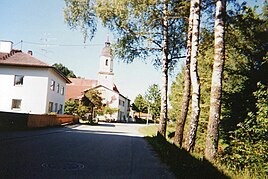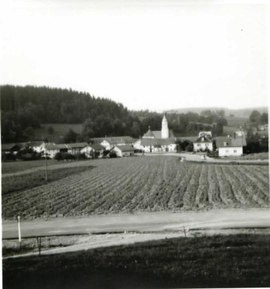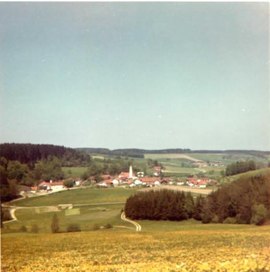Oberornau
|
Oberornau
Community Obertaufkirchen
Coordinates: 48 ° 13 ′ 0 ″ N , 12 ° 14 ′ 0 ″ E
|
|
|---|---|
| Height : | 483 m above sea level NHN |
| Incorporation : | July 1, 1972 |
| Postal code : | 84419 |
| Area code : | 08082, 08073 |
|
Oberornau, town center
|
|
Oberornau is a district of Obertaufkirchen , a municipality in the Upper Bavarian district of Mühldorf am Inn .
geography
Geographical location
Oberornau is located in the region of southeast Upper Bavaria in the Ornautal, through which the Ornaubach flows; a tributary of the Goldach .
geomorphology
The landscape around Oberornau clearly shows the traits of its ice age and interglacial history. This is an old moraine area from the Riss period , which began around 240,000 years ago. During the Riss period, the section from Peterskirchen via Heldenstein and Schwindkirchen formed the old moraine area in this area . The meltwater that ran off deepened the valleys and gullies and deposited masses of mud and debris carried along with it. During the last cold period for the time being, the Würme Ice Age (130,000 - 20,000 BC), the newly advancing Inn Glacier came at the height of Gars am Inn and Haag i. OB to a standstill.
history
Late Middle Ages
Among the first known landowners in our country were the Bavarian dukes from the house of the Agilolfingers , above all Tassilo III. After his fall in 788, with the consent of the Carolingian King Karl (later Charlemagne ) , his property went all to the Salzburg clergy. This possession is proven in the two shortly after the fall of Tassilos III. created descriptions of Salzburg's properties , the Indiculus Arnonis and the Breves Natitiae, recorded in 788 and 790 under the first Salzburg Archbishop Arn .
Among the property that was passed over there are also three parochial churches with a total of seven hubs on the Ornau : "Ad Aharnouua ecclesiae III cum mansis VII". This meant: today's Oberornau and probably Pfaffenkirchen and Obertaufkirchen.
Around the year 923 one finds in the records of the diocese of Salzburg (Cod. Odalberti No. 97 a) the transfer of ownership from Birnbach (Pirchinapach) from the noble Eparhart, a feudal man of the archbishop, to the diocese of Salzburg. In 924 (Cod. Odalberti Nr. 44) Oberornau passed from the previous owner diocese of Salzburg to the "Noble Frau Rihni". This is also the second oldest written mention of Oberornau.
The Giebinger and Ornau nobility
Haselberg
Around 1150 the noble Hazaga de Haselperge (Haselberg) is mentioned at the convent in Au . In 1180/90 one encounters the brothers Dietmar and Ulrich von Haselberg in the records of Au.
On March 27, 1313, the knight Chunrat from Hoselperig is listed as a guarantor in an Au tradition.
Oberornau (Ornau)
Since the beginning of the 10th century. the Ornau lords were among the vassals of the Counts of Ebersberg : Dietrich approx. 935/60, Sintbert approx. 1050/55, Dietrich approx. 1080, Rotbert approx. 1095/1100.
Over the years, the cohesive property split up, which is also expressed in the place names Frauenornau, Oberornau and Ornau (near Weidenbach). In the 12th century you first meet Hermann von Ornau and then his son Heinrich.
1127/35 which is free and vassal of the governors of Mödling, Sigboto of Ornau mentioned. A generation later, the name appears in connection with Giebing and Niederhaim (Niederham).
Middle of the 12th century. Rudiger de Arnowe and his son of the same name are mentioned several times in rows of witnesses. Rudiger was formally subordinate to the aforementioned Sigboto or his wife, a daughter of Bailiff Kuno IV.
Probably a relative of Sigboto was Heinrich von Ornau, approx. 1165–1204. He acted as salmann for judge Heinrich senior (probably his father) on a farm in Niederham.
The local nobility of Ornau can be found in several documents from the 12th century: 1135 are named Henricus, Dietricus and Ulricus de Arnowe, 1160 Rudiger de Arnowe, 1180 Hermanus de Arnowe. The line died out around 1200.
Hofgiebing (Giebing)
A local nobility can also be proven in Hofgiebing .
The first officially mentioned nobleman in the area is mentioned in 935 in the records of the Emmeran monastery in Regensburg. His name was Gotschalk von Giebingen. (Hof-) Giebing is also one of the oldest aristocratic residences in the area. The name Gotschalk persisted until the 13th century. Between 1130 and 1147 and between 1210 and 1220 one also encounters the name "Gotscalcus de Giebinge" in the Auer tradition books.
In the year 1123 the noble free Herman von Giebing is mentioned in the records of the diocese of Salzburg . This family was also wealthy in nearby Rimbach. Around 1150, his son of the same name is mentioned in a document from the Gars monastery .
An older (around 1150/55) and a younger (around 1180/90) Sigboto von Giebing can be found in the records of the Diocese of Freising . This is probably Sigboto von Niederham, who was in the service of the Freising diocese.
Around 1150 the brothers Konrad and Ulrich von Giebing are mentioned several times in the Auer tradition books. They were knights of the Regensburg clergy. A younger Ulrich von Giebing, probably a son of Konrad, can be found in connection with the governors of Mödling (Stampfl near Au am Inn). From here on, the Giebinger's turning away from the Regensburgers and the connection with the Mödlingers and thus the Salzburg ministerials becomes evident.
Heinrich von Giebing is mentioned for the first time around 1130/40 as Salmann (land manager, court administrator) of the Salzburg Ministerial Jedung. The second Heinrich, probably a brother of the younger Ulrich, is mentioned in a series of Auer witnesses around 1160. From 1204 onwards, a third Heinrich appears quite often as a witness. He had two brothers: Heimo and Rudiger, and two sons: Kuno and Ulrich.
1257 Konrad von Giebing is mentioned in a Raitenhaslach series of witnesses. In a document dated December 28, 1287, Konrad von Giebing bequeathed his estate in Liopfing to the monastery of the Auer Canons. Konrad von Giebing had two sons. Heinrich died before his father, from the other son, Saxo, we know that he was the last of the Giebinger family. In 188 Saxo von Giebing renounced his feudal estates in Eberharting, in Bietsheim bei Weidenbach, in Kagen and in Krafting in favor of Archbishop Rudolf von Salzburg on the condition that neither he nor his successors were allowed to lend them.
Saxo von Giebing and his wife Gysila, daughter of Friedrich von Chuntel (Kundl), had no descendants. Her Hofgiebingen property goes to the Bavarian Duke Otto III around 1300. over.
After the death of Saxon von Giebingen, the Hofmark Hofgiebing was administered by ducal ministers. In contrast to the episcopal, the lower jurisdiction was transferred to these, which was expressed in the name Hofmark.
Giebing stayed until the beginning of the 16th century. owned by the Bavarian dukes. When the Schwindegg Castle was burned down by the Palatinate soldiers in the Landshut War of Succession in 1504/1505 , Duke Albrecht V of Bavaria gave the seat and the Hofgiebing court to the Schwindegg lord of the castle, Jakob von Fraunhofen, as compensation. In 1558 the Hofmark Hofgiebing is in the hands of Veit Marschalk von Pappenheim. In 1580 Giebing came to the nobles of Haunsperg from near Laufen ad Alz. Sebastian von Haunsperg fought in the Battle of Lepanto in 1571. He died in 1605. He was followed by Ferdinand, who died in 1616 at the age of 27. This was followed by Magdalena von Haunsperg. Via the Bavarian Duke, Giebing came into possession of the Baroness von Moreau. In 1848, in the course of the administrative and court reorganization, the lower jurisdiction of the court brands was abolished. This also meant the end of the Hofmark Hofgiebing. The property was transferred to the property belonging to the Hofmark. Today nothing can be seen of the castle. This was removed. Only the moat can partly be seen.
The political municipality 1818 - 1972
In 1818 the foundations for the formation of rural communities ( rural communities ) were created in the Kingdom of Bavaria . In the municipality register of the regional court Mühldorf from August 20, 1819, the regional court administered 54 municipalities, including Oberornau with 100 families (1 village, 8 hamlets, 38 wastelands). On May 23, 1838, the Haag regional court was founded (until 1804, Haag was the seat of a regional court) from parts of the Wasserburg, Erding and Mühldorf regional courts . From then on, the district court of Haag was responsible for Oberornau with its 500 inhabitants. With an order of January 27, 1840, the tax districts incorporated into the Haag Regional Court, including Oberornau, were outsourced to the Mühldorf Rent Office and assigned to the Wasserburg Rent Office. This created the prerequisite for future membership of the Wasserburg am Inn district (until 1939 the district administrations were called the district office ).
From 1920 to 1960 Oberornau had its own medical care. First, from 1920 to 1935, Dr. Ruhland in Oberornau. He was followed by Dr. Hesse.
In 1912 a state police post was set up in the old school building in Oberornau and manned by two gendarmes. Until the state police post was abolished in 1960, they had to maintain order in the area between Haun in the east and Gatterberg in the west, as well as Schwindkirchen in the north and Ramsau in the south.
From 1931 until the 1990s, Oberornau had its own post office.
church
see also: List of architectural monuments in Obertaufkirchen
The church of Oberornau, which was mentioned as early as 788, dates back to the late Gothic period. During the Baroque transformation in 1767, Balthasar Mang , painter in Kraiburg, adorned the ceiling with four paintings (the crucifixion of Christ, the crucifixion of the apostle Andrew, St. Peter and the bishop Simeon of Jerusalem). St. Andrew has always been the patron of the church. The 14 baroque Stations of the Cross, painted on wood, renovated in 1836 are also remarkable. The lively designed Rococo high altar shows a bewildering wealth of figures and shapes; the altar figure of the church patron can be exchanged for a Madonna figure by means of a rotating mechanism. Further church restorations were carried out in 1865 and 1895. In 1928 the parish church was expanded under Pastor Neumair and a year later it was equipped with a new organ with 26 sounding stops and 1685 pipes. It is the work of the organ builder Georg Glatzl in Altmühldorf. The church peal from five bells has a total weight of 100 hundredweight.
The Oberornau Expositur 1887 - 1921
Already in the first half of the 12th century. the parish of Oberornau lost its independence and is only mentioned as a branch church of the parish of Reichertsheim. This state lasted for 750 years. Only with the status of an expositur (the parish of Reichertsheim) was more independence achieved again.
The Expositi (clergy) of Oberornau
| Term of office | Surname |
|---|---|
| 1887-1888 | Peter Antretter from Oberflintsbach |
| 1888-1892 | Bernhard Schmid from Aiglsbach near Regensburg |
| 1892-1894 | Stephan Reinthaler from Reibersdorf, Parish Obertaufkirchen |
| 1894-1901 | Anton Bauer from Munich |
| 1901-1905 | Wilhelm Garner from Nuremberg |
| 1905-1916 | Ludwig Weiß from Kienberg |
| 1916-1918 | Andreas Ziegler |
| 1918-1920 | Josef Farnhammer |
| 1920-1921 | Johann Neumair |
The parish of Oberornau
The remaining records on the Oberornau Expositur end in 1901, those on the Oberornau parish begin in 1929.
In 1921 the Expositur Oberornau was raised to a parish and Expositus Johann Neumair became the first pastor of the new parish.
The pastors of the parish of Oberornau
| Term of office | Surname |
|---|---|
| 1921-1949 | Johann Neumair |
| 1949-1971 | Karl Götz from Mengersreuth near Regensburg |
| 1971-1976 | Josef Neumann |
| 1976-1995 | Hermann Josef Egerer from Marienbad in Bohemia |
| Tadeusz Kmiec-Forstner | |
| Jozo Karlic |
school
In the 19th century, the Wimmer family of sacristans in Oberornau did a lot for the school. Josef Wimmer was a teacher from 1815 to 1859 and also a sacristan and organist. In 1862 a school house was built and the school was occupied by the first trained teacher, Johann Kilger. In 1910 a new school building with two school halls was built, with the old school building being used by the rural police until it was closed in 1960. As part of the district reform in 1972, the independent municipality of Oberornau (former district of Wasserburg am Inn ) was incorporated into the municipality of Obertaufkirchen (district of Mühldorf am Inn) and, as a result, the Oberornau elementary school was dissolved during this time.
politics
The political community of Oberornau existed until the regional reform in 1972.
Population development
| year | Residents | year | Residents |
|---|---|---|---|
| 1824 | 432 | 1925 | 647 |
| 1838 | 500 | 1939 | 561 |
| 1875 | 514 | 1948 | 950 |
| 1890 | 547 | 1950 | 810 |
| 1900 | 552 | 1956 | 599 |
| 1907 | 608 | 1965 | 520 |
| 1916 | 598 | 1971 | 489 |
Personalities
- Maike Conway (* 1967), documentary filmmaker and director, lives in Oberornau
- Fredl Fesl (* 1947), Bavarian. Dialect singer and humorist, lived in Oberornau for several years
- Wilhelm Hesse (1888–1960), "da doctor", lived in Oberornau in the doctor's house from 1934 and practiced there as a doctor until 1958. He was the owner of the Hesse-Schlößl (see: Laughter from the outside. From my life 1918–1933 . By Oskar Maria Graf) in Burgau in Wasserburg am Inn. His friends included u. a. the painter Karl Wähmann, the writers Oskar Maria Graf and Joachim Ringelnatz .
- Hanns Vogel (born August 13, 1912 in Munich-Schwanthalerhöhe, † November 14, 2005 there), German dramaturge, writer and theater manager and founder of the Munich authors' association, Munich Tower Scribers . He lived in Oberornau for several years.
literature
- Sigfrid Hofmann (Red.): City and district of Wasserburg am Inn. Past and present. Homeland book. = Heimatbuch Stadt und Landkreis Wasserburg am Inn. Hoeppner, Pörsdorf near Assling / Obb. 1962.




